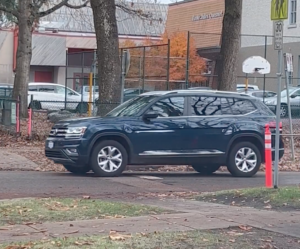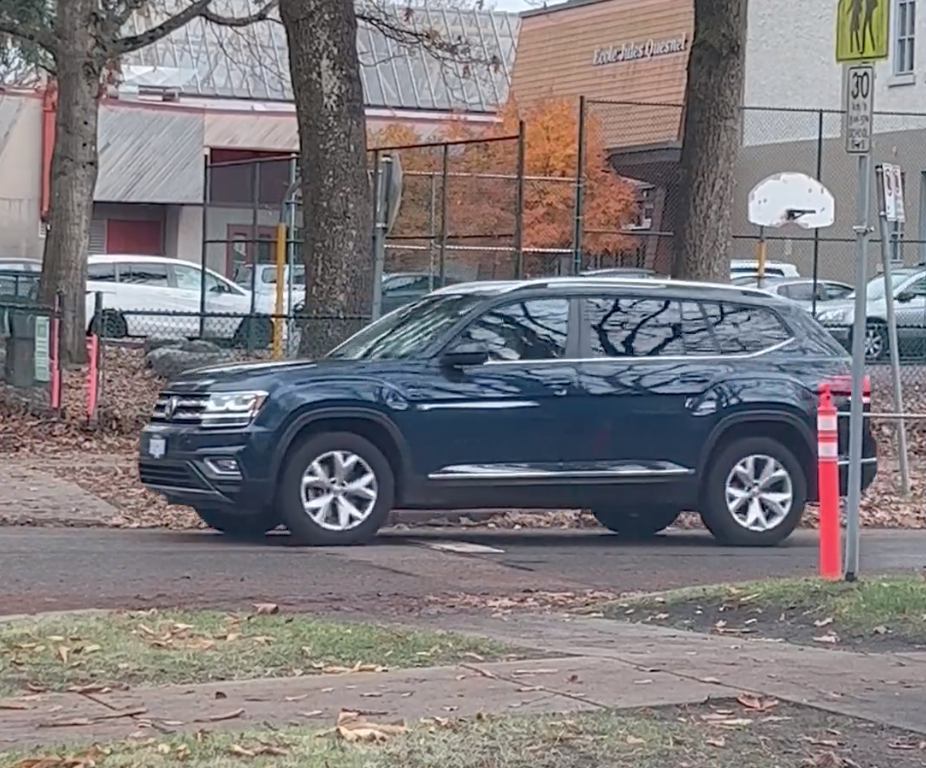

Prairie Paul on twitter is King’s Counsel lawyer Paul Doroshenko. He has posted a series of images on twitter as he waited to pick up his child at a west side Kitsilano primary school .
The photo above is a crossing that goes from the school grounds and joins up with the existing sidewalk across the street. There is a stop sign, and lots of signage indicating that this is a school zone.
Back to the stop sign. Mr. Doroshenko who practices criminal defence and drunk driving law witnessed vehicles ignoring the stop sign and continuing at speed through the crossing.
As if they were not next to an elementary school with children who have little acuity about vehicle timing and distance until they are 12 years of age.
You will also notice that there is no road paint indicating a cross walk on the road. That requires permission from the City of Vancouver who are often reticent to create additional crosswalks around schools. Often city engineering staff have a “warrant system” approach to when they will allow a crossing to be painted on, especially mid block.
The “warrant system” is an outdated standard to assess whether a problem area deserves a type of traffic control to be placed on it. Staff can include vehicular driver volume, pedestrian volume, and “crash experience” in evaluating whether to design an elevated crosswalk and/or mark the street for a crosswalk. You can take a look at some items used in a warrant here from the Manual of Uniform Traffic Control Devices.
Outside a school there should never be an opportunity for drivers to exceed the posted speed of 30 km/h or to ignore stop signs. And it should not take a “crash experience”, an injury or death in the “warrant system” for the intersection to be made safer for children. If you have ever listened to area residents talk about traffic issues, they are the experts on what goes on, and many minor brushes are not reported to the Vancouver Police Department or the Provincial vehicle insurer, ICBC.
There is a lot of power in a can of white latex paint to produce crosswalk lines. There are lots of examples of well placed and painted crosswalks done by community members that have been kept and maintained after a resident intervention.
I have done some planning and traffic calming work in the area around this school, and also assisted the school principal at the time out of a crashed vehicle in a serious road collision. In years past “someone” had actually dug up some of the street signs around the school which prohibited parking and moved them, to create more parking and stopping zones.
This shows the need for ongoing diligence by City Hall and the importance of creating street environments around schools so that every life matters. Expanding the current “school street” program to include several blocks around schools would be a good first step.
This was reinforced at the International Road Safety Symposium earlier this month by Dr. Tarek Sayed, the Canada Research Chair in Transportation Safety and Advanced Mobility at the University of British Columbia. Dr. Sayed bluntly stated that there is a reactive reliance on collision data to inform changes in road design which has fundamental ethical implications. This approach stops engineers from trialing promising innovative but untested safety treatments. It also ignores the complex collision factors and how safety measures work.
A quick review of the subject location of the street where drivers are blowing through the stop sign shows that drivers need to change their behaviour.
That can be accomplished by monitoring cameras (which have been very effective in reducing speed and saving lives/serious injury in school zones in NYC), increasing police enforcement, education or changes in road design.
Creating a “speed table” or large raised speed bump which becomes a raised crosswalk across the street for children could also be considered. The first one was installed at Lord Selkirk Elementary on East 22nd Avenue.
But as Dr. Sayed points out, it is necessary to act now on modifying the crossing and changing driver behaviour, and not wait until there is a serious injury or worse.















There’s far too much empathy for this behaviour from school administratorsand cops. “But she’s just picking up her child!” Fine and shame them until it stops. Zero sympathy.
Author
Dan, there was a principal at Annie B. Jamieson that used to stand in the middle of the school’s crossing intersection with a trenchcoat every morning during school drop off. Every day. He said even his presence in the middle of the street did not change parent driver behaviour. Every parent wanted to drive their kid to the door of the school, despite his best efforts to change behaviour. Would better education, enforcement, and better road design make a difference?
If you’re going to attempt to change behaviour, why not ask why kids are being driven to school in the first place? It’s healthier to walk. Perhaps educators should spend more time promoting the “Walking Bus” – check it out on Wikipedia:
https://en.wikipedia.org/wiki/Walking_bus
Author
Sean, Thank you! And even better is the Portland School Bike Bus, complete with music! That’s coming up in a new post.
as well as steep fines from cops – but they are not interested. At least they weren’t when I was working in schools. Some schools tried to encourage parents not to drive within a block of a school but the effort didn’t get enough enforcement. Getting students to educate their parents was the most effective.